Independence of Finland
Finland declared its independence on 6 December 1917. The formal Declaration of Independence was only part of the long process leading to the independence of Finland.
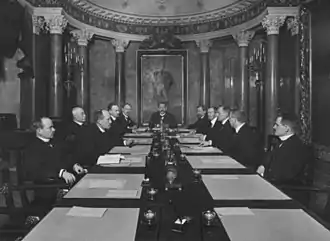
Proclamation of Empress Elizabeth (1742)
The subject of an independent Finland was first mentioned in the 18th century, when present-day Finland was still ruled by Sweden. On 18 March 1742, during the Russian occupation in the Russo-Swedish War (1741–1743), Empress Elizabeth of Russia issued a proclamation in the Finnish language to the Finnish people asking them to create a Finland which would be independent from both Sweden and Russia.[1] This led to preparations to create a Kingdom of Finland in 1742. The Finns elected Duke Peter of Holstein-Gottorp (who later became heir to the throne of Russia and Tsar as Peter III) to be the King of Finland. However, the political situation had outgrown the idea of Finnish independence and it quickly evaporated.[2]
Anjala conspiracy (1788)
The Anjala conspiracy was a scheme in 1788–1790 as a response to end Gustav III's Russian War, and it included the independence of Finland to some degree. Several people involved were linked to Walhalla-orden. Russian occupations and plundering of 1713–21 (the "Greater Wrath") (Finnish: Isoviha) and 1741–43 (the "Lesser Wrath") (Finnish: Pikkuviha) were still in vivid memory when Finns waged partisan warfare against the Russians.
Georg Magnus Sprengtporten, who took no direct part in the conspiracy, had written a proposal for a Finnish constitution in 1786. Sprengtporten later had a role in forming the autonomous Grand Duchy of Finland within the Russian Empire, as he became the first Governor-General of Finland after Sweden ceded the rest of Finland to Russia in 1809 at the conclusion of the Finnish War.[3]
Birth of a nation
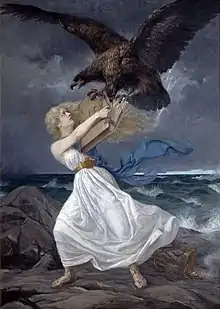
According to professor Martti Häikiö, before a nation declares independence, it must develop a national identity and certain institutions.[4] Governing bodies for Finland were developed after 1809, when it was “elevated as a nation among nations” (as declared by Tsar Alexander I) by becoming an autonomous Grand Duchy of Finland under the Russian tsar. The Diet of Finland met regularly from 1863.
National identity grew simultaneously with Pan-European nationalism. Johan Ludvig Runeberg and Elias Lönnrot created an idealized image of Finnish people and Finnish nature in the 1830s and 1840s.[5] Also J. V. Snellman was a central person in national romanticism and the modern nationality debate. He encouraged the use of the Finnish language (instead of Swedish) among the educated classes during Finland's language strife.[6] The Finnish markka was introduced as currency in 1860 by the Bank of Finland, which Snellman pegged to silver instead of the ruble.[6] During the Famine of 1866–68, Snellman worked to obtain aid and distribute it in a country with low resources and undeveloped communications.[6]
Elisabeth Järnefelt held the literary salon Järnefelts skola (Järnefelt School), which became a center of the Fennoman movement. During the time 1880–1910 the golden age of Finnish art coincided with the national awakening. The central figure of the time was Akseli Gallen-Kallela. Other notable people were Aleksis Kivi and Albert Edelfelt.
The fennoman motto was:
- "Swedes we are no more,
- Russians we cannot become,
- therefore Finns we must be."[7]
The first period of Russification of Finland (Finnish: Ensimmäinen sortokausi) began in 1899 with the February manifesto of Nicholas II when Nikolay Bobrikov was Governor-General of Finland.[8][9][10] As a response, the cultural address Pro Finlandia was gathered with 523,000 names, and a delegation of 500 people was sent to Saint Petersburg to deliver it.[11] The Kagal resistance movement formed at this time. In 1901 Russia tried to alter the nature of the Finnish army with a new conscription law, which demanded that Finns not only defend Finland, but also fight for Russia on any front. Finnish resistance grew into a mass movement, and only half of the eligible men reported for duty.[12] Bobrikov was shot in 1904 by Eugen Schauman, who shot himself afterwards.[9][13] The Finnish newspaper Päivälehti, which had been censored before, was closed permanently as a result of an editorial written about the assassination. Jean Sibelius composed In Memoriam in memory of Schauman.[13] The steamship SS John Grafton unsuccessfully attempted to smuggle large quantities of arms for the Finnish resistance during the Russo-Japanese War (1904-1905). The Finnish general strike of 1905 temporarily halted russification.

During 1905–1908 Leo Mechelin formed a government and created a liberal democracy with the universal right to vote and be elected. In 1906 the unicameral Parliament of Finland was created, with universal and equal suffrage.[14] However, the power of the parliament was limited by the tsar from 1908–1916.
The second period of Russification of Finland (Finnish: Toinen sortokausi) in 1908 and World War I led activist groups to unite. Under Franz Albert Seyn, Bobrikov's successor as Governor-General, all legislation was moved to the Russian State Duma, which then pushed for laws restricting Finnish autonomy. Russia demanded higher payments and the Senate of Finland was replaced with the admiral-senate or saber-senate.[15] Nicholas II pushed for complete russification and the end of Finnish autonomy in 1914, but this was halted by the beginning of the First World War. The Jäger Movement was formed and sent first 200, and later 1900, Finnish volunteers to Germany to be trained as Jägers (elite light infantry) for armed resistance.[16] The Finnish Jägers formed the 27th Jäger Battalion and were eventually sent to Libau to fight against the Russian Empire. Sibelius composed the Jäger March on lyrics written by Heikki Nurmio, who served in the 27th Battalion.[17]
Discussions in 1917
Revolution in Russia
The February and October Revolutions in 1917 ignited hope in the Grand Duchy of Finland. After the abdication of Tsar Nicholas II on 2 March (15 March N.S.) 1917, the personal union between Russia and Finland lost its legal base – at least according to the view in Helsinki – as he was the Grand Duke of Finland. Negotiations began between the Russian Provisional Government and Finnish authorities.
Power act
The resulting proposal, approved by the Russian Provisional Government, was heavily rewritten in the Finnish Parliament and transformed into the so-called Power Act (Finnish: Valtalaki, Swedish: Maktlagen), whereby the Parliament declared[18] itself to now hold all powers of legislation, except with respect to foreign policy and military issues, and also declared that it could be dissolved only by itself. At the time of the vote it was believed that the Provisional Government would be quickly defeated by the rebellion in Saint Petersburg. The Provisional Government survived, however, and disapproved of the Power Act and dissolved the Finnish Parliament.
After new elections and the ultimate defeat of the Provisional Government in the October Revolution, the Finnish Parliament decided to create a three-man regency council,[19] based on Finland's Constitution, and more precisely on §38 of the old Instrument of Government of 1772, which had been enacted by the Estates after Gustav III's bloodless coup. This paragraph provided for the election of a new monarch in case of the extinction of the royal line and was interpreted in Finland as vesting sovereignty in the Estates, later the Parliament, during such an interregnum. The regency council was never elected, however, because of the strong opposition of Finnish socialists and their general strike of 1917 which demanded more radical action.
On 2 November (15 November N.S.) 1917, the Bolsheviks declared a general right of self-determination, including the right of complete secession, "for the Peoples of Russia". On the same day, the Finnish Parliament issued a declaration by which it assumed, pro tempore, all the powers of the Sovereign in Finland.[20]
The old Instrument of Government was, however, no longer deemed suitable. Leading circles had long held that monarchism and hereditary nobility were antiquated, and advocated a republican constitution for Finland.
The Declaration and 15 November
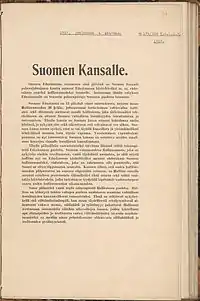
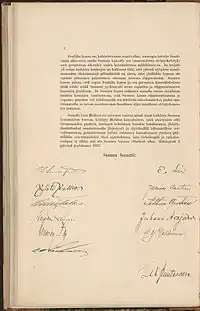
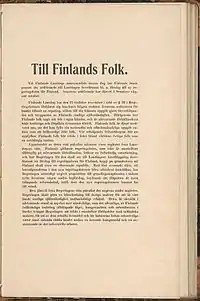
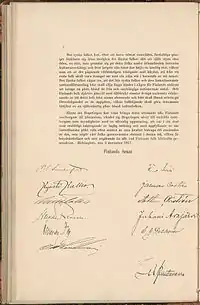
Pehr Evind Svinhufvud formed a Senate which started on 27 November 1917. Its goal was to execute independence as soon as possible. The Senate returned to the Parliament with a Declaration of Independence and proposal for a new republican Instrument of Government on 4 December. The Declaration of Independence was technically given the form of a preamble of the proposition, and was intended to be agreed upon by the Parliament. Parliament adopted the Declaration on 6 December with 100 votes against 88.[21]
With reference to the declaration of 15 November, the new declaration says:
The people of Finland have by this step taken their fate in their own hands; a step both justified and demanded by present conditions. The people of Finland feel deeply that they cannot fulfil their national and international duty without complete sovereignty. The century-old desire for freedom awaits fulfilment now; Finland's people step forward as a free nation among the other nations in the world. (...) The people of Finland dare to confidently await how other nations in the world recognize that with their full independence and freedom, the people of Finland can do their best in fulfilment of those purposes that will win them a place amongst civilized peoples.
International recognition
Svinhufvud immediately asked Sweden, Norway, Denmark, Germany, and France to recognize Finland's independence. The West, however, said they would wait until the former ruler, Russia, recognized the declaration. They told Svinhufvud to talk to Lenin's Bolshevik Government. Svinhufvud was hesitant to do this, as he did not want to recognize the Bolsheviks as the legal rulers of Russia. Besides, he thought that the Bolshevik government would probably fall soon. So the parliament decided to ask for recognition from the Russian Constituent Assembly. Germany, which was in middle of peace negotiations with Soviet Russia, pressured Finns to talk to Lenin and the Council of People's Commissars. Svinhufvud followed their advice, as Finland wanted Germany's recognition as soon as possible.[22]
On 18 December (31 December N.S.), the Soviet Russian government issued a decree recognizing Finland's independence,[23] and on 22 December (4 January 1918 N.S.) it was approved by the highest Soviet executive body, the All-Russian Central Executive Committee (VTsIK).[24]
The independence of Finland was recognized by Germany, Sweden, and France on 4 January 1918, by Norway and Denmark on 10 January, and by Austria-Hungary on 13 January.[25]
List of recognition
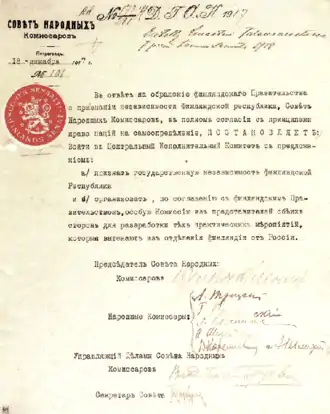
| State[26] | Date [26] |
|---|---|
| 4 January 1918 | |
| 4 January 1918 | |
| 4 January 1918 | |
| 4 January 1918 | |
| 5 January 1918 | |
| 10 January 1918 | |
| 10 January 1918 | |
| 11 January 1918 | |
| 13 January 1918 | |
| 28 January 1918 | |
| 21 February 1918 | |
| 21 February 1918 | |
| 21 February 1918 | |
| 2 March 1918 | |
| 11 May 1918 | |
| 23 July 1918 | |
| 9 October 1919 | |
| 8 March 1919 | |
| 6 May 1919 | |
| 7 May 1919 | |
| 23 May 1919 | |
| 10 June 1919 | |
| 17 June 1919 | |
| 23 June 1919 | |
| 27 June 1919 | |
| 18 August 919 | |
| 27 October 1919 | |
| 19 December 1919 | |
| 26 December 1919 | |
| 31 December 1919 | |
| 8 April 1920 | |
| 18 April 1920 | |
| 17 May 1920 | |
| 25 June 1920 | |
| 13 July 1920 | |
| 23 August 1920 | |
| 3 June 1921 | |
| 25 October 1921 | |
| 27 July 1922 | |
| 17 July 1928 | |
| 1 December 1928 | |
| 20 February 1931 |
Organizing a new country
Hardship burdened the common people, resulting in polarization, and soon ignited the Civil War. The declaration actually addresses this problem:
The Government will approach foreign powers to seek the recognition of our political independence. All the complications, famine and unemployment ensuing from the present external isolation make it urgent for the Government to tie direct contacts with foreign powers without delay. Urgent, concrete assistance in the form of necessities for living and industry is our only rescue from imminent famine and industrial standstill.
Many of the necessary ministries and authorities had been founded during years of autonomy, and they continued their activities perhaps after a change of name. The Bank of Finland had the same position as before. As pilotage has military significance, the National pilot office had been subjected to russification. The National Board of Navigation, later called the Finnish Maritime Administration, was founded 15 December 1917, and piloting became its responsibility.[28][29]
The attempt to establish a monarchy in Finland failed and in 1919 Kaarlo Juho Ståhlberg became the first president. The first parliamentary elections were held in March 1919.
National symbols

From several suggestions, the parliament selected a blue and white flag, which was flown over the house of parliament on 28 May 1918.[30] The Coat of arms of Finland, with a crowned lion on a red field had existed since Swedish rule.[31]
Selection of the national anthem divided social classes. The conservatives preferred Maamme by Runeberg and Pacius, while the working class was singing La Marseillaise and The Internationale. After the whites won the Civil war, Maamme was chosen.
6 December was declared the national holiday Finland Independence Day. The bill to make Finland a republic was passed by the Diet in 1919.
Commemoration
The 90th Anniversary of Finland's Declaration of Independence was selected as the main motif for the €5 90th Anniversary of Finland's Declaration of Independence commemorative coin, minted in 2007. The reverse shows petroglyph aesthetics, while the obverse has a nine-oar boat with rowers as a symbol of collaboration. Musical symbols and Finnish kantele strings are also included in the coin's design.
See also
References
- Szíj Enikő (1979). Finnország. Budapest: Panoráma. p. 56. ISBN 963 243 111 1.
- Singleton, Fred (1998). A Short History of Finland. Cambridge University Press. p. 51. ISBN 9780521647014.
- "Sprengtporten, Georg Magnus (1740 - 1819)". Biografiakeskus. Retrieved 2017-12-07.
- Haikio, Martti. "Kansakunta itsenäistyy – näkökulmia Suomen valtiollisen itsenäistymisen 100-vuotisjuhlan viettoon". itsenaisyys100 (in Finnish). Helsingin Suomalainen Klubi. Retrieved 2 November 2017.
- Matti Klinge. "Runeberg, Johan Ludvig (1804 - 1877)". The National Biography of Finland. Retrieved 24 November 2017.
- Klinge, Matti. "Snellman, Johan Vilhelm (1806 - 1881)". The National Biography of Finland. Retrieved 24 November 2017.
- Kari Tarkiainen: Adolf Ivar Arwidsson, in Matti Klinge (ed.): Suomen kansallisbiografia 1. SKS, Helsinki 2003, ISBN 951-746-442-8 (page 406)
- Johnson, A.; Bickford, C., Hudson, W., Dole, N. Cyclopedic Review of Current History. Volume 9. Garretson, Cox & Co. 1899 page 198 and following
- Kauffman, George B.; Niinistö, Lauri (1998). "Chemistry and Politics: Edvard Immanuel Hjelt (1855–1921)". The Chemical Educator. 3 (5): 1–15. doi:10.1007/s00897980247a.
- "1899. The Collection of Decrees of the Grand Duchy of Finland. No 3". Retrieved 2017-12-09.
- "Pro Finlandia". Retrieved 2017-12-09.
- "The Russian Empire". Finland: A Country Study. Library of Congress. 1988. Retrieved 26 December 2016.
- "Other orchestral works / In Memoriam". Jean Sibelius. Finnish Club of Helsinki. Retrieved 2017-12-07.
- "Parliamentarism in Finland". Finland.fi. Retrieved 12 June 2016.
- Markku Tyynilä. "Historiaa: Amiraalisenaatin oikeusosasto". Retrieved 2017-12-08.
- "The Finnish Jaeger Movement". Embassy of Finland, Riga.
- "The war and the fifth symphony 1915-1919". Jean Sibelius. Finnish Club of Helsinki. Retrieved 2017-12-07.
- "Hallituksen esitykseen, joka sisältää ehdotuksen laiksi erinäisten asiain siirtämisestä Suomen senaatin ja kenraalikuvernöörin ratkaistavaksi" (in Finnish). 25 July 1917. Retrieved 8 February 2014.
- D. G. Kirby (1980). Finland in the Twentieth Century: A History and an Interpretation. Minneapolis: University Of Minnesota Press. p. 47. ISBN 978-0816658022.
- "Eduskunta". Suomi 80 (in Finnish). Tampere University. Retrieved 20 August 2016.
- Osmo Jussila – Seppo Hentilä – Jukka Nevakivi (1999). From Grand Duchy to a Modern State: A Political History of Finland Since 1809. London: C. Hurst & Co. p. 103. ISBN 0 8093 9112 0.
- Hajo Holborn (1969). A History of Modern Germany: 1840-1945. Princeton University Press. p. 492. ISBN 0 691 05359 6.
- "Primary Documents - Soviet Recognition of Finland's Independence, 18 December 1917". first world war. Retrieved 20 August 2016.
- "On This Day - 4 January 1918". first world war. Retrieved 20 August 2016.
Eastern front: Bolshevik Government recognises independence of Finland.
- Szíj Enikő (1979). Finnország. Budapest: Panoráma. p. 93. ISBN 963 243 111 1.
- "Suomi ulkomailla". Finland abroad. December 6, 2020. Retrieved December 6, 2020.
- Janne Ridanpää (December 6, 2020). Maailmanympärimatka Helsingissä suurlähetystöt ja niiden historia. Helsinki: Otava. p. 152. ISBN 978-952-5805-86-4.
- "Autonomian ajan viranomaiset". Arkistojen portti (in Finnish). Archives of Finland. Retrieved 26 December 2016.
- "Finland - International Hydrographic Review". Centre for Digital Scholarship Journals. Retrieved 26 December 2016.
- "Quirks of history: Finnish flag created in a restaurant back room?". Suomifinland100. Archived from the original on 1 December 2017. Retrieved 12 June 2016.
- "Coat of Arms". finland.fi. Retrieved 26 December 2016.
External links
- Finland as a state in 1917 - Itsenäisyys100
